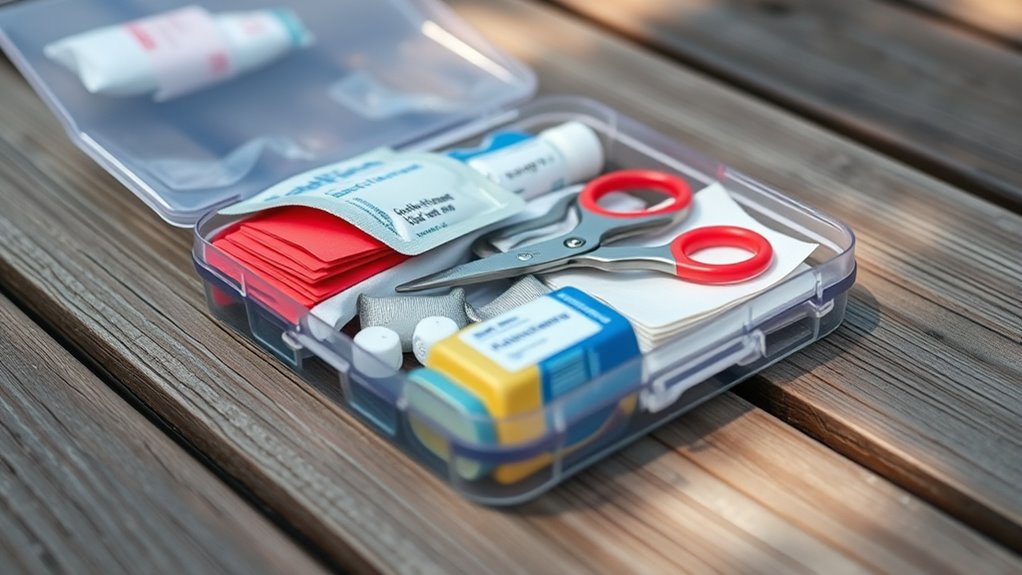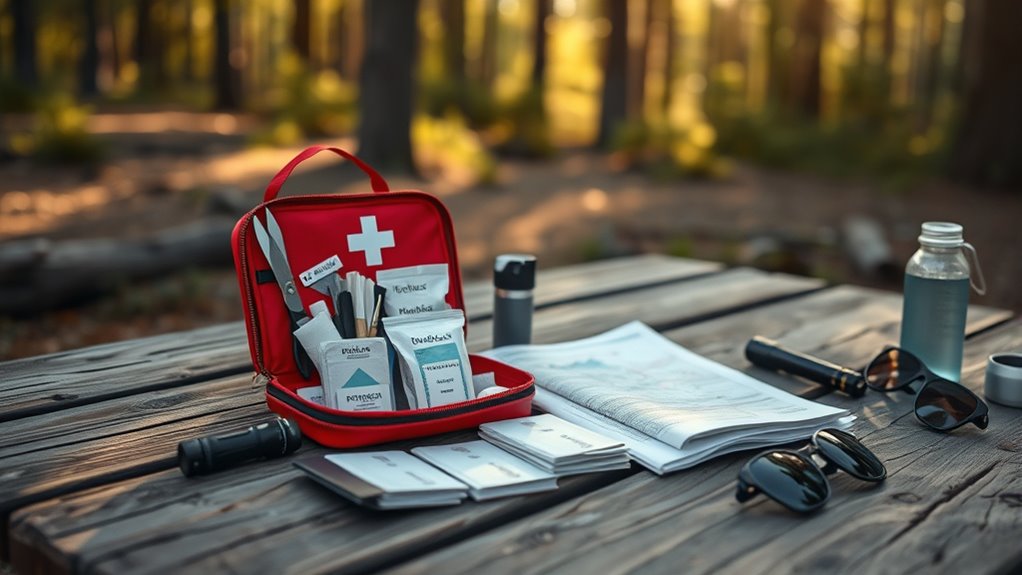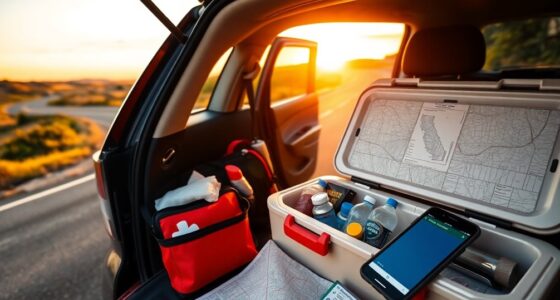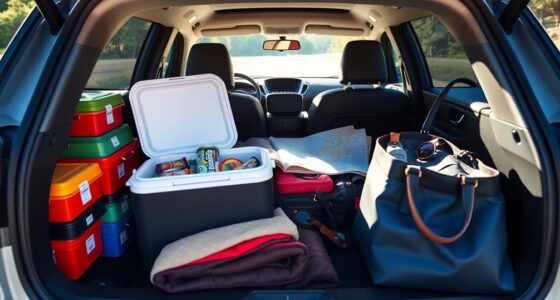To prepare your car-camping first-aid kit, include essentials like adhesive bandages, antiseptic wipes, sterile gauze, and pain relievers to handle common injuries. Add tools such as tweezers, scissors, a whistle, and a flashlight for emergencies. Don’t forget personal items like hygiene supplies and any necessary medications. Keeping everything organized and accessible is key. If you want to guarantee you’re fully equipped, you’ll find more helpful tips below.
Key Takeaways
- Include adhesive bandages, antiseptic wipes, sterile gauze, and antibiotic ointment for quick wound care.
- Carry pain relievers, antihistamines, and necessary prescriptions in a sealed, accessible container.
- Pack tools like tweezers, scissors, a whistle, and a flashlight for emergency response and visibility.
- Ensure the first aid kit is organized for rapid access and review its contents regularly.
- Consider special needs such as allergy medications or diabetic supplies based on individual health requirements.
Basic Medical Supplies for Immediate Care

When an injury occurs during a camping trip, having the right basic medical supplies can make all the difference in providing immediate care. Injury prevention starts with essentials like adhesive bandages, antiseptic wipes, and sterile gauze to treat cuts and scrapes quickly. Proper medication storage is vital, so include a sealed container for pain relievers, antihistamines, and any prescriptions. Keep medications in a cool, dry place to maintain effectiveness. Having these supplies ready helps you address minor injuries promptly and reduces the risk of infection. Remember, organized and accessible basic medical supplies ensure you’re prepared for common camping mishaps, making your trip safer and more enjoyable. Proper injury prevention and first aid skills are key to quick, effective first aid response. Additionally, familiarizing yourself with wound care techniques can further enhance your ability to handle emergencies confidently. For added safety, consider including preventative supplies like insect repellent and sunscreen to avoid other outdoor hazards.
Tools and Equipment to Handle Emergencies

Having the right tools and equipment on hand is essential for effectively managing emergencies during a camping trip. Proper first aid kit organization guarantees you can quickly find what you need, saving valuable time. Additionally, emergency contact planning helps you stay connected and coordinate with others if needed. Your kit should include:
Being prepared with organized tools and an emergency plan ensures quick responses and peace of mind during camping trips.
- Waterproof flashlights or headlamps
- Tweezers and scissors for removing debris
- Adhesive tape and bandages of various sizes
- A whistle for signaling for help
- A portable phone charger or power bank
These tools enable you to address injuries promptly and keep communication lines open. Keeping everything well-organized and accessible allows you to respond efficiently, reducing stress and preventing minor issues from escalating. Always review your emergency contact plan before heading out. Incorporating continuous learning and adaptation into your preparations ensures you stay equipped to handle unexpected situations effectively. Regularly updating your first aid skills based on new information or training can significantly improve your response in emergencies, especially when dealing with developmental milestones that often emphasize preparedness and resilience.
Personal Items and Special Considerations

Personal items and special considerations are vital to guarantee comfort, safety, and well-being throughout your camping trip. Prioritize personal hygiene by bringing items like hand sanitizer, moist towelettes, and toothbrushes to stay clean and prevent infections. Proper medication storage is essential, especially if you take prescription drugs; keep them in a waterproof container and within easy reach. Consider any special needs you or your companions might have, such as allergy medications or diabetic supplies. Packing these personal items ensures you can maintain health and comfort during your outdoor adventure. Remember, staying clean and organized not only boosts morale but also reduces the risk of illness, helping you enjoy your trip without unnecessary worries. Additionally, incorporating hygiene maintenance tips into your planning can help manage stress and enhance your overall experience. As technology advances, it is also important to be aware of data privacy concerns, especially when using digital devices or apps during your trip. Being aware of Bitcoin IRA considerations can also help you plan financial safety measures if you wish to manage digital assets safely while camping. Incorporating nutrition considerations by packing healthy, low-carb snacks can also support your energy and overall well-being during outdoor activities.
Frequently Asked Questions
How Often Should I Update My Car-Camping First-Aid Kit?
You should check your car-camping first-aid kit at least once a year to make certain everything is in good shape. Perform seasonal maintenance by inspecting for expired items and replacing them promptly. Always pay attention to kit expiration dates and replace medications or ointments as needed. Regularly updating your kit keeps it ready for emergencies, especially if you go camping frequently or change your supplies based on seasonal needs.
Are There Specific Items for Treating Common Outdoor Injuries?
Did you know that nearly 80% of outdoor injuries are minor, yet proper wound management is vital? You should include items like antiseptic wipes, adhesive bandages, and sterile gauze for injury prevention and treating cuts or scrapes. A pair of tweezers helps remove splinters, while cold packs reduce swelling. These essentials guarantee you’re prepared to handle common outdoor injuries swiftly, keeping everyone safe and comfortable during your adventure.
Should I Include Medications for Allergic Reactions?
You should definitely include allergy medications and emergency antihistamines in your kit. If someone has a severe allergic reaction, quick access can be lifesaving. Carrying over-the-counter antihistamines like diphenhydramine helps manage mild symptoms, but emergency antihistamines meant for severe reactions are vital. Always check expiration dates and make certain you know how to use them properly. Being prepared means you can respond promptly and effectively to allergic emergencies during your outdoor adventures.
How Can I Organize My Kit for Quick Access?
To organize your first-aid kit for quick access, use a clear labeling system and compartmentalization. Label each section for specific items like bandages, medications, and tools, so you can find what you need instantly. Keep frequently used items upfront or in easily reachable compartments. Regularly check and update your labels and contents, ensuring everything stays organized and ready whenever an emergency arises during your trip.
What Training Is Recommended for Using Advanced First-Aid Tools?
Did you know that only 10% of people with first aid certification feel confident handling advanced tools? To effectively use advanced first-aid tools, you should pursue specialized training like wilderness rescue techniques. A first aid certification provides a solid foundation, but practicing with advanced equipment boosts your confidence and skills. Enroll in courses that focus on wilderness scenarios to prepare you for emergency situations where quick, expert intervention is essential.
Conclusion
Now that you know the essentials for your car-camping first aid kit, are you truly prepared for every emergency? Having the right supplies on hand can make all the difference when moments matter most. Keep your kit well-stocked, accessible, and tailored to your needs. After all, isn’t being prepared the best way to enjoy your adventure with peace of mind? Stay safe out there and camp confidently!









